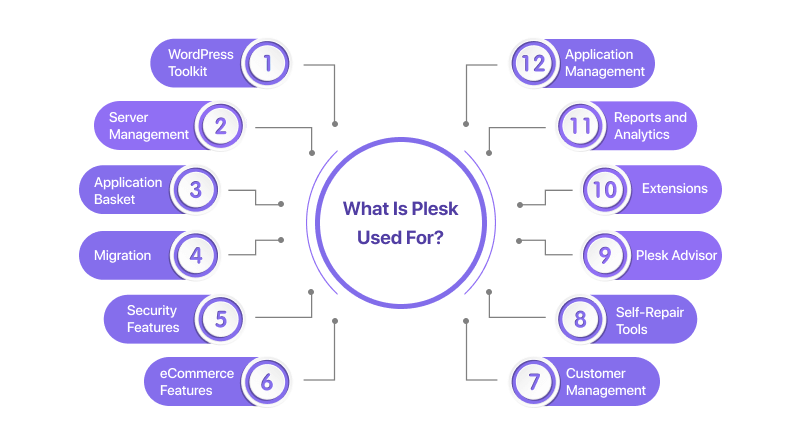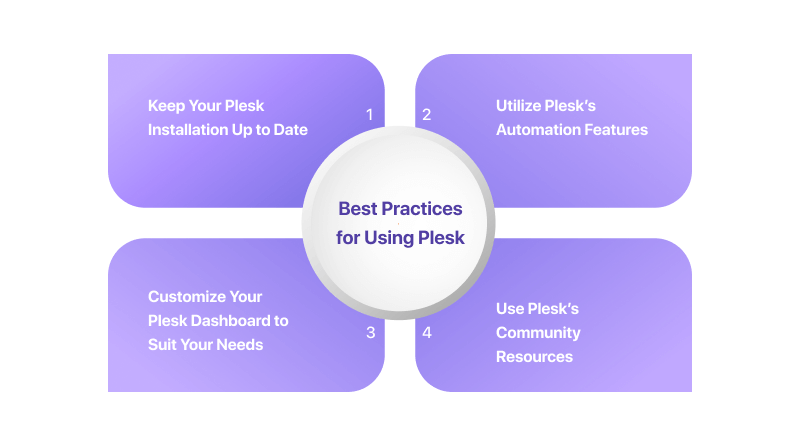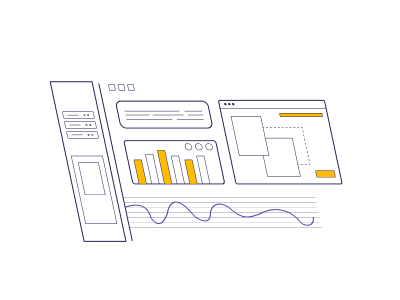Whenever there is a requirement for an innovative control panel to manage domains and FTP accounts, cPanel and Plesk are popular names. A major difference between both is that cPanel is accessible only on Linux OS while Plesk supports Windows OS & Linux OS servers. You will get this product inclusive with Windows VPS hosting or Windows dedicated hosting.
Managing email accounts, databases and other technical attributes of the web hosting account is easier with the help of this intuitive control panel. But what is plesk? Plesk automates the tasks like backups, script updates, and others. Here is an introductory guide for beginners who have just begun their web hosting journey with the Plesk control panel.
Table of Content
What is Plesk?
Plesk was introduced in 2001 to automate the growing applications, websites, and hosting business. As of current data, Plesk is operating in more than 384,000 servers 11M+ websites, and 15M+ email boxes. In more than 140 countries, the top 100 web hosting providers including MilesWeb are leveraging the Plesk control panel today. Plesk International GmbH, a Canada-based software company has developed it. Its branches are in Switzerland, Spain, Germany, Japan, and Russia.
With the help of Plesk, SysAdmins and SMBs (Small and Medium Businesses) get a top-quality control panel with all sets of secured features. It is a web hosting control panel that processes the request between the user and the system.
For instance, if a user uses Plesk GUI to build a website, the control panel propagates the request to a new Apache or IIS web server. Then, it later adds a new virtual host to the system. This process gives administrators more flexibility and control from the single interface to manage the technical aspects of operations.
What Is Plesk Used For?
Let’s move on to the section where we will be discussing what is plesk used for?

1. WordPress Toolkit
WordPress toolkit in the Plesk allows users to update, install, and delete WordPress websites from their server database. Also, it enables the creation of plugins and install updates with the server monitoring feature.
2. Server Management
Plesk makes the server management task easier. Admins can manage, monitor, and control the performance of different users using a single dashboard. Beginners can refer to our guide where they can learn to manage users in the Plesk.
3. Application Basket
There are different applications helpful for your website development tasks. With Plesk, you can install them on your server with just a few clicks. There are different popular CMS (Content Management Systems). WordPress, Joomla, and Drupal, eCommerce platforms such as Magento, OpenCart, and PrestaShop, and CRM software such as SugarCRM and vTiger are available in the plesk control panel that you can install within a minute.
Moreover, admins get the accessibility to continue with the relevant applications. Or else, they can disable them if they find anyone irrelevant.
4. Migration
Plesk eases the migration process of websites or web apps from external web hosting control panels like cPanel. If your VPS or Dedicated server demands the Plesk-to-Plesk migration, it is possible with this plesk control panel.
5. Security Features
Plesk safeguards the domain with advanced security features including a firewall, malware scanning, data backups, and password protection. Besides, 2-factor authentication (2FA) disallows hackers to execute the intrusion activity. All your applications are protected with Plesk hosting servers.
6. eCommerce Features
Plesk has multiple built-in eCommerce features like product inventory management, shopping cart setup, and payment gateway integration. All these features help e-store owners manage and grow their shopping carts.
7. Customer Management
Customers have the freedom to get access to Plesk’s support portal. They can easily manage their accounts, upgrade to additional services, and reduce the heavy IT workload. As a result, customers can easily perform technical operations and manage their tasks alone.
8. Self-Repair Tools
Command Line (CLI) AND GUI-based tools are introduced by Plesk to automatically fix the errors without affecting the server performance.
9. Plesk Advisor
Plesk Advisor is a tool that helps in monitoring and improving the server’s performance. The tool helps in optimizing the server’s performance, stability, and security. It will highlight different parameters to score and work on the areas of improvement on your website to boost its performance.
10. Extensions
There are 150+ Plesk extensions that users can install to boost their website’s capabilities. For example, CloudFlare integration, a backup manager, an SEO toolkit, server usage monitor, and many more extensions are available in the Plesk that can be installed in just a few clicks.
11. Reports and Analytics
Monitor your website’s real-time analytics and performance to make informed decisions. Refer to different metrics and implement appropriate strategies to make your website a topper in the search engine results. Traffic, performance, and visual metrics are given in the Plesk dashboard which helps users easily interpret the information.
12. Application Management
Install and manage your applications easily with the Plesk control panel. Save your valuable time by installing applications like blogs, forums, and eCommerce sites within just a few clicks. Even users with less technical expertise can use its interface without any trouble. Still issues occur, they may connect with a managed Windows hosting service provider.
Best Practices for Using Plesk
Here are some best practices that you can use to make the most out of the Plesk control panel.

1. Keep Your Plesk Installation Up to Date
Like other software, Plesk also releases new features and patches to be in the trend. Here are some benefits of installing the latest Plesk updates.
- A manual update yearly is not needed every time.
- New features are accessible immediately.
- Security vulnerabilities are no more in the updated version.
- Boost in speed and performance.
There are two Plesk variants, Onyx and Obsidian. MilesWeb uses Obsidian having top-class security configurations and improved UI, more features, and regular updates.
2. Utilize Plesk’s Automation Features
Plesk has different automation features that run PHP scripts, execute custom commands, and fetch URLs. As a result, there is no requirement for manual efforts and saves lots of time.
Updates and data backups can also be automated with Plesk. When you automate these tasks, you ensure you always have the latest security patches and data reserves in case of cyber attacks.
Plesk also lets you update other software on your VPS automatically, such as WordPress plugins and themes.
3. Customize Your Plesk Dashboard to Suit Your Needs
There is a beginner-friendly user interface in the Plesk that helps in better customization. To make it happen, Log in to Plesk, Go to Tools & Settings → Plesk Appearance.
Maintain a better workflow and personalize user experience with server options like:
- Changing the default language of the administrator’s interface.
- Redirecting the users to another webpage
- Redirecting users to another web page with a custom button.
- Customizing the default Plesk logo and title.
In Plesk, users can modify elements like the color scheme, background, font, and others. For this, they need to have basic expertise in Plesk’s stylesheet.
4. Use Plesk’s Community Resources
Users can ask questions and find resources in Plesk’s community or refer to the Plesk Hosting Guide. forum if they are still unsure how to use Plesk. Discussion topics include Plesk for different operating systems, WP toolkits, and extensions in this forum.
In Plesk’s community resources, you can find assets and instructions on various management tasks. Additionally, Plesk has official documentation explaining how to use the control panel.
How to Stage a Website Using Plesk?
An independent clone of your live website is a staging website. Software, hardware, and settings on this website are the same as on your live website. In this sense, the staging website is useful when you are changing the code and content of your website. By performing a few simple steps, Plesk allows you to easily configure a testing environment for your website. Refer to our guide: Using Plesk To Stage Websites
Key Features of Plesk
Now, we would like key features of Plesk in the spotlight.

1. Modern Web Stack
Your Plesk VPS includes an optimized web stack, allowing you to quickly deploy a website. Stack components include:
- You can manage PHP software libraries and dependencies using the Composer. Also, single-click dependencies installation is possible with it.
- Docker integration features the application distribution within a container. Moreover, users can also run additional services available in the Docker Hub.
- MongoDB Database is a user-friendly database ensuring scalability and flexibility. MongoDB is easy to install in a Docker container. It can handle all database management activity through the control panel.
2. Integrated Security
If you are using the Plesk VPS hosting services, do not ignore the importance of security factors. Here are some integrated security features that it holds.
- Plesk dashboard makes installation of SSL certificates from various Certificate Authorities (CAs).
- Don’t compromise on security standards with the integrated firewall management in the Plesk.
- Plesk diagnoses and fixes errors along with their automatic repair with self-repair tools.
- Server Name Identification (SNI) security feature in Plesk prevents spammy visitors and avoids email breaching activities.
- Plesk’s advanced tracking system monitors the server resources to boost the performance of your websites and applications.
3. Backup and Restore
Plesk has cloud-based storage which makes maximum storage easier for users. Different types of data like websites, email accounts, and domains are easy to store in the cloud storage. There are potential cyber attacks that are riskier for your websites and applications. The plesk control panel reduces this risk as well and backup your data regularly. Users can schedule automatic backups to ensure data safety.
4. DNS Management
If managing your DNS data is a challenging task, Plesk is here to savior. There are different sets of DNS records to manage like nameserver, TXT records, and A records. By choosing Plesk, you can usually host them for a domain on your hosting environment itself. Moreover, the customization of each add-on domain is possible with this control panel.
5. File Manager
Organization is key. What is the best way to keep track of all the files on your server? Uploading, removing, and managing these files should be easy. Therefore, your control panel should provide a GUI that enables quick and easy file management. Simplicity is key. File management is a basic daily task for admins, regardless of whether they use a CMS like WordPress.
Using a file manager also makes it easier to resolve CMS issues. FTP (File Transfer Protocol) is an alternative, still supported by most control panels. FTP requires the use of a separate software application, which you’ll have to install separately.
6. Custom Error Pages
While running a web hosting operation in the Plesk, there should be no room for errors. It looks unprofessional for your website. Hence, users can customize a range of messages in a worthy control panel.
Customize the error message descriptively and professionally that does not disengage any website visitor. In the customized error message, you can provide a navigation option and the company logo also if required. All these attributes of Plesk help website owners.
Plesk Advantages: Unveiling the Benefits
Multi-Server Management
Plesk solves the problem of multiple server management. It has a centralized control panel that streamlines the management process. Also, it oversees multiple servers and applications using a single interface. Overall, the website management complexity is reduced. Plesk control panel is so advanced that it changes the PHP versions as well.
Enhanced security
As discussed in this blog, plesk control panel ensures a seamless acquisition and SSL certificate configuration directly from the dashboard. Whether it is a firewall management or other element, this web hosting control panel safeguard servers from potential cyberthreats.
It leverages SNI (Server Name Identification) protocol to restrict unauthorized access. There are different server monitoring tools and the self-repair tool to ensure a minimum downtime and shield server’s integrity.
Increased Functionalities with Extensions
Plesk control panel enhances the website’s functionalities with seamless extensions integration. You can enable/disable PHP extensions with the Plesk and contribute to the website’s scalability. Also, the extensions catalog offers over a hundred add-ons, and you can install them by navigating to Extensions on the sidebar, searching for the tool you need, and clicking Get it Free. You can also purchase paid extensions directly from the Plesk dashboard.
Plesk is such a control panel that you will get with most of the web hosting panels. It is an important consideration while choosing hosting plans to manage your domains, databases, and accounts with a user-friendly GUI. Key features as we mentioned below are its major USPs.
1. Modern web stack
2. Integrated security
3. Backup and restore capabilities
4. WordPress toolkit
If you want to try it first, there is a free trial by MilesWeb in the Plesk web hosting service for 7 days. In these 7 days, users will get the time to evaluate the quality of services and accessibility to check the best fits to their needs. Websites with growing traffic demanding flexibility, and scalability can opt for web hosting services with a Plesk control panel due to easy management features.
What is Plesk FAQs
What is Plesk used for?
Plesk is a web hosting control panel that helps users manage their websites, domains, email accounts, databases, and security settings. It’s like a user-friendly dashboard for your server, allowing you to perform various tasks without needing technical expertise. Here are some key uses:
1. Website and application hosting: Set up and manage websites, applications, and even WordPress installations easily.
2. Domain management: Register, transfer, and manage your domain names all in one place.
3. Email management: Create and manage email accounts, set up autoresponders, and configure security features.
4. Database management: Create and manage databases for your websites and applications.
5. Security management: Implement firewalls, malware scanners, and other security measures to protect your server.
6. Automation: Automate tasks like backups, updates, and script executions.
Is Plesk the same as cPanel?
Both Plesk and cPanel are popular web hosting control panels, but they have some key differences:
1. Interface: Plesk boasts a more modern and user-friendly interface, while cPanel has a more traditional look and feel.
2. Features: Plesk offers a wider range of features, including application management, server management tools, and WordPress integration. cPanel focuses primarily on website management.
3. Cost: Plesk is generally more expensive than cPanel.
Who should use the Plesk control panel?
Plesk is a good choice for:
1. Individuals and businesses: Easy to use for managing personal websites or small business websites.
2. Web developers and designers: Offers advanced features for development and management.
3. Resellers: Allows reselling hosting services with its multi-client management features.
What platforms does Plesk support?
MilesWeb offers a Plesk control panel with Plesk VPS and Windows hosting services. Hence, if you choose Plesk hosting services, it is supportive of Windows OS only.
Do I need technical knowledge to use a Plesk host?
The beauty of Plesk is its user-friendly interface. While some advanced features might require technical knowledge, basic website management tasks can be done even with minimal technical skills. Many hosting providers also offer support and tutorials to help you get started.








